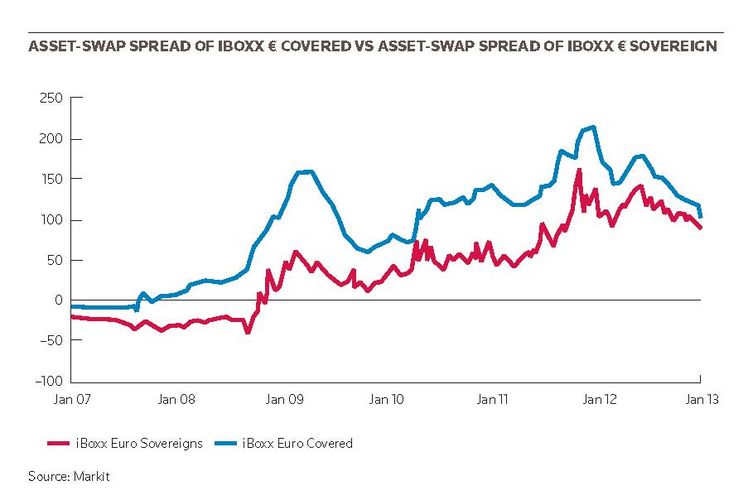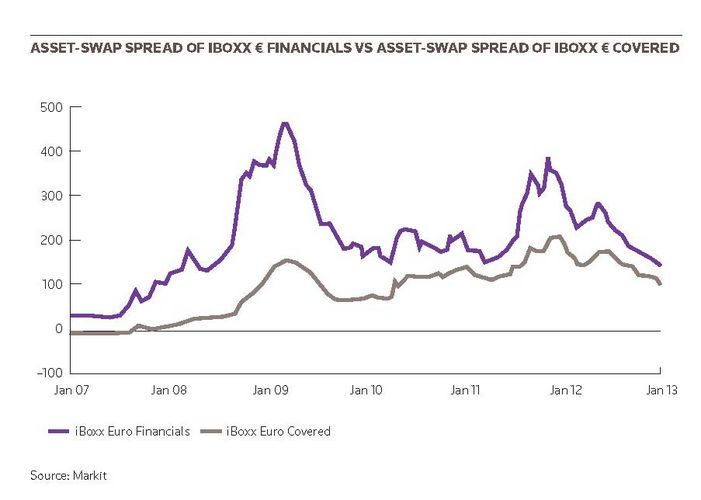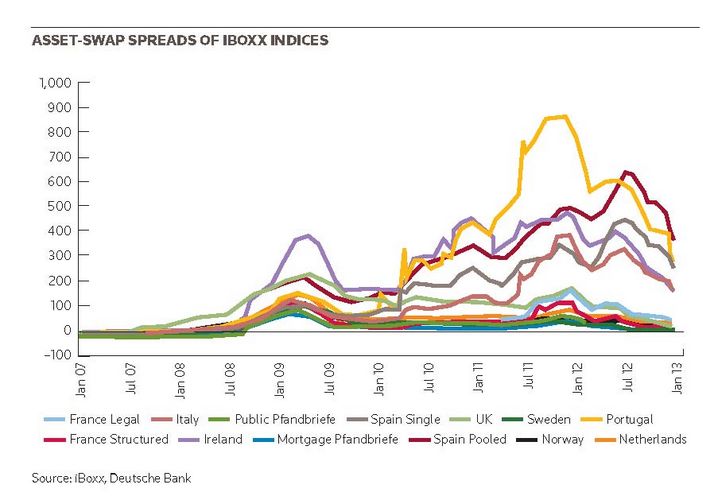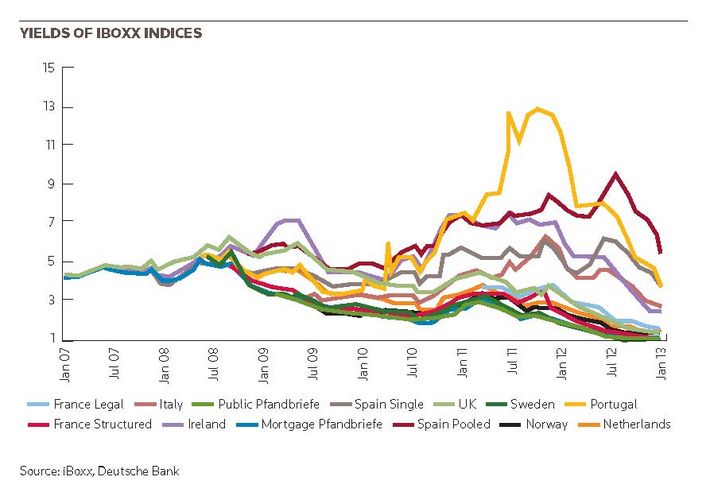To view the digital version, please click here.
IFR: On the point of economics, a lot of the banks going to the public market are saying they want to replace LTRO funding and stand on their own two feet. Will funding costs eventually come down to the point where it is economic for issuers?
Stephane Bataille: Well, what happened in the LTRO tender pretty much matched our expectations. We were expecting around €100bn to be returned; in fact it was a bit higher. If you are an institution in France, in Germany or the Netherlands, you may have an economic incentive to give the money back because it’s cheaper to replace LTRO money through short-dated covered bonds or even senior financials, which is what we’ve been seeing in France.
But if I’m an institution in Spain and Italy I mean, quite frankly, I would be a bit silly to give back huge sums of LTRO money. Just think of an institution in Spain or Italy where there’s, say, €5bn of LTRO money placed in government bonds, where they have maybe a carry of 300bp or so, which earns them additional revenues of €100m to €150m. Some banks in Spain are maybe only profitable because they have LTRO money. So, it makes absolutely no reason to give it back. I don’t think they’ll do it and nor will they be forced by governments or central banks to do it.
So what you will see is the composition of LTRO money change again. I think 82% so far has been allocated to banks in peripheral countries. I guess that will go up to 90% or 95%. But of course you cannot rely only on central bank funding. Every treasurer who’s not using pockets of demand is crazy. If I can issue up to 10 years I should use every opportunity to do so to reduce the reliance a little and smooth my ALM profile.
IFR: I’d like to talk about the emergence this year of new jurisdictions in covered bonds. Singapore, South Korea and Latin America are all mentioned in this context. Will they emerge and where? Is there demand in the European market or perhaps in US dollars?
Stephane Bataille: Australia and New Zealand will probably continue to heavily supply the market, especially Australia. When it comes to Japan to Korea, I’ve been talking to Asian issuers for over half a decade now. I think I first pitched covered bonds to Japanese banks as long ago as 2006. They aren’t particularly quick so this isn’t something I’m really focusing on.
Torsten Elling: The success of covered bonds last year was undoubtedly seen across all markets. So, from that perspective there are different countries looking at it. Clearly there is a lack of legislation in most of these countries that are looking at it currently so their banks are trying to use financial engineering to replicate covered bonds as closely as possible.
As to the question of demand, of course there’ll be demand for these kinds of countries. There will be demand for these kinds of issuers. New markets offer another way of diversifying your covered bond investments.
I’m not sure which country will be first but the ones you mentioned are definitely the ones which are on our radar screen as well. Given the fact you have a very strong established US dollar market it makes it even easier because issuers don’t have to rely on the dollar or euro basis swap back to their own currencies. They can pick and choose whether they want to issue in dollars and keep it in dollars or swap it back in their own currency or do a euro deal and cater to the deeper and more sophisticated investor base. They also have the chance to do sterling if they want to. So, from that perspective I’m positive about all the changes. Yes, there will be something coming up in 2013 and I’m looking forward to it.
IFR: Moving now to the topic of covered bond lookalike instruments, such as SME loans packaged into covered bond-type bonds, can we expect to see more of these coming through?
[NOTE: On February 21, after this Roundtable took place, Commerzbank priced a €500m Structured Covered Bond with a 1.5% coupon secured by a portfolio of SME loans. The bank pointed to the contractual structure of the bonds as having similar features to Pfandbriefe. The issue enabled the issuer to extend its long-term refinancing options. Commerzbank reported more than €1bn of demand from over 60 institutional investors, more than half of which were outside Germany.]
Matthias Melms: First of all I think it’s an interesting idea to use SMEs as a funding tool in a collateralised transaction but I have a problem seeing it as a covered bond in the traditional sense. Look, SME lending is a large business for a lot of banks and if you can use such collateral to refinance, I think it’s a good idea.
Look at Turkey; it’s not an old or a big covered bond market, but it’s possible to use SMEs. Look at the discussions in Austria and Italy where they’re working on changing the law to put it on a legal basis.
The important thing is that here in Germany we have a strong legal basis under which banks can only issue Pfandbriefe against mortgages, public sector loans, ship mortgages and, since we [NordLB] did the first issue last July, aircraft receivables. And now we have the first SME transaction which is not based on the German Pfandbrief Law.
I think we should be careful that we draw a line between Pfandbriefe and structured covered bonds. I’m not sure if you can compare them; They’re different funding tools. The SME bond is a very useful funding tool and I’m pretty sure there will be large demand from the investor side but it is not a Pfandbrief. We should bear that in mind.
Ralf Burmeister: Looking at the ECBC definition, it isn’t a covered bond due to the type of collateral. The ECBC clearly states it’s just mortgages or public sector loans that define it as a covered bond. The other thing is, with all the SME stuff. I think it’s a bit a reversal of what we know from the covered bond world. OK so it’s term funding. You go out and execute term funding with collateral that is very short term so you have high frequency turnover in the pool and you have long-dated bonds outstanding against it. It’s a little bit a reversal of what we know from the established covered bond world.
Another thing is support. I mentioned earlier support from the ESM/EFSF etc. Notwithstanding anything can happen to government bonds these days, but there is some kind of support in the eurozone. We’ve also seen support for national mortgage markets. Is that the case for alternative assets? That’s one thing I would like to ask.
The next challenge, beside the support story, is tranching of the balance sheet. So we create so-called covered bonds – so-called covered bonds was the expression used earlier; I was paying a lot of attention to that – that are very close to securitisation. If you have assets that are not familiar to the covered bonds universe, and if you have pass-through cashflow structures and replications of existing covered bond frameworks, we are getting ever closer to securitisation and I think that’s a threat.
The funny thing is, looking at the efforts now in place in Austria and Italy where you have initiatives to pass legislation that allows for SME covered bond issuance, I’m not sure if it’s the case in Italy but it’s definitely the case in Austria that they will not call the instrument Pfandbrief. They will call it something else. I think that’s very odd. I fully agree with Mathias. We have to draw somewhere a line and it comes down to index membership and whether it’s within the corresponding covered indices, the ABS indices etc. I should also mention that this issue is coming up in the US too.
We’ve seen a lot of investors going for the Pfandbriefe asset class and issues are pricing through governments. Why? Because of the perceived high recovery value rate. Will we get that will all of these innovations? Or is there a risk of watering down or somehow diluting the asset class? This is complex.
Let me make something very clear, though. I’m not arguing against innovation. I think it’s good that banks use all the channels they have and get away from central bank funding. Don’t get me wrong. If that’s a method and if that is perceived well by investors why not go for it? I’m not arguing against it. But we have to pay attention to what it’s called, how it’s marketed and where it’s placed in the index world because the index world is tremendously important for investors.
If these instruments somehow end up in the wrong index and investors wake up and realise, “OK we wanted this type of covered bond and not the other ones because we have doubts and there’s no track record of perceived recovery rates for that stuff, it’ll create a negative feedback loop.
IFR: So you’re not saying you wouldn’t buy them you’re just saying there needs to be transparency about what they are.
Ralf Burmeister: Yes.
Jens Tolckmitt: At the VDP, we also see it as a very important addition to the funding mix. But, as everybody said before it is very important to differentiate it from the original product. I think we have come a long way in that respect. We have been discussing these products for about a year to 18 months now. At the beginning, when we looked at Germany, the way people tried to market these kinds of issues was very close to Pfandbrief.
Today, if you look at the wording, they accept it’s a different product and they are marketing it in a different way and not trying to get any of the glamour of the traditional product in terms of pricing. What is extremely important and what I mentioned the very beginning is in the regulatory framework: we have very, very, very favourable treatment for covered bonds. I think this is justified but we are the only asset class with this favourable treatment. If you look at securitisation, it’s the total opposite (which may be unjustified) but some market participants and political players are looking sceptically at the favourable treatment given to covered bonds.
Secondly you can be sure that there will be regular reviews as to whether this treatment is justified. This is already starting, by the way, with work that the EBA has to do over the next few years with regard to covered bonds. I think the whole industry would be well advised to look at the quality of the product. We think it must be part of the product development of the traditional covered bond to clearly define the boundaries and to clearly ringfence the asset class in order to make sure that when regulators conduct reviews, they see the preferential treatment as justified.
I think by diluting the quality we are risking this. That is what our concern is all about. But we think the SME covered bond can be a very important addition to the overall funding mix. But make it clear it’s not a Pfandbrief and it’s not a traditional covered bond.
IFR: Stefan, would you like to respond to that?
Stephane Bataille: We have never marketed this as an SME Pfandbrief. We said it’s a structured covered bond backed by SME loans. We are not misleading investors or mis-marketing the deal. For me, it’s still a structured covered bond as it’s issued by a bank, not by a corporate and it’s a dual recourse debt instrument. We know it does not fit within the traditional Covered Bond definition as this bond is neither backed by public sector assets nor mortgage loans.
However, I wouldn’t rule out having a discussion in the coming years around whether SME loans can be accepted as collateral for legally-based covered bonds. One day we may also have a discussion with regards to car loans backing structured covered bonds. I like car loans but don’t get frightened; we don’t have anything in the pipeline at the moment. There is a clear distinction to be made between traditional Pfandbriefe and any structured covered bond and I don’t see why this should change.
Torsten Elling: Can I just make some observations? On the one hand, we’re saying it doesn’t qualify as a covered bond under the ECBC definition because it’s not backed by mortgages or public sector loans. But what about ship or aircraft Pfandbriefe? Then you mentioned term funding where you feel that if SME loans were short-term funded by let’s say five year maturities it doesn’t really fit. But we had the same discussion with short-dated public sector assets funded by long term bonds.
Ralf Burmeister: Not necessarily. There is short-dated paper out there but if you look at the actual life of the loan, the contractual life of the loan in the SME business, it might be three or five years but it’s actually repaid on an earlier schedule so the economic life is much shorter. That’s not necessarily the case for public sector loans.
Torsten Elling: OK but thinking specifically about Germany: knowing how strong the Mittelstand is, there’s certainly a discussion to be had. I’ll leave it there and leave it open to interpretation.
Joerg Huber: I mean as long as corporates can refinance themselves cheaper than banks in senior format, you know, these things are out there to discuss.
Stephane Bataille: One thing I like about SME covered bonds is that you can quickly monetise the pool as the average life of the loans is very short. Typically in public sector transactions it was the opposite. You had some bad quality 30 or 40-year assets for instance from Greece and you issued a short dated covered bond against it. In case of issuer insolvency it would have been impossible to monetise the pool.
Another point I like about SME Covered Bonds is that you are also buying exposure to the corporate sector and have a somewhat different correlation. Remember the huge outperformance of corporate debt versus financials we witnessed after the Lehmann collapse. Covered Bond investors ended up with exposure to indebted European sovereigns or an overheated housing market plus exposure to vulnerable banks, in every respect they were buying exposure to the banking sector.
Jens Tolckmitt: As I said we are not against this kind of covered bond. But from a political point of view; I would just be very cautious about being too proactive in promoting this being comparable to a traditional covered bond. If, for example, you look at Solvency II, just to use one very striking example, it has taken legislators 12 years, so far – and it’s not about to end –12 years to put in place what we currently have as a framework.
We are happy that for traditional covered bonds, we’ve gotten preferential treatment for everything above Double A. The same is true for all the regulatory initiatives we’ve seen over the past few years. It’s still a very fragile framework which is why it’s very dangerous, while the ink is not yet dry, to already be thinking about how this could develop over the next five years and confront regulators with it because we risk losing the preferential treatment we have and nobody wants that.
Matthias Melms: I want to mention another point on the SME issue. If we come back to the theme of asset encumbrance, we’re now taking another asset class from the balance sheet and reserving it for a special type of investor. Maybe not now, not tomorrow or even next year but in the future if SME covered bonds become a funding tool for banks, the regulator may well ask if taking another asset class, a very important asset class for a lot of German and European banks and reserving it for a special type of investor is the way to go. I wonder if it wouldn’t lead to some kind of restrictive treatment.
Ralf Burmeister: If some years down the road you have SME deals issued under special covered bond law, when it comes to regulation I’m just wondering: on the one hand banks get the allowance to use any kind of assets – Stefan was mentioning car loans –under the covered bond law and possibly being exempt (that’s at least the aim) from any kind of bail-in. On the other hand, banks have to have senior unsecured debt and a minimum amount of bail-inable capital.
I think it’s getting messy. At least in the German case, Pfandbriefe are explicitly exempt from any kind of resolution bail-in because it’s the one and only covered bond type we have in Germany including aircraft and shop Pfandbriefe. If you open up the whole balance sheet of a bank to covered bond issuance,
I think regulators at a certain point of time run the risk of contradicting themselves and not knowing where they’re heading. This is why I also support Jens’s argument saying we must be careful what we are doing and from a technical point I would say rating-wise those structures may be eligible under LCR …
Stephane Bataille: I don’t think so because it’s not a covered bond.
Ralf Burmeister: Exactly it goes back to user definition.
Stephane Bataille: At this stage it’s most likely not LCR eligible. Again we are open and transparent. We are not saying we are selling an SME Pfandbrief and by the way I’m not pitching car loan Pfandbriefe; I’m just saying I like the collateral. Why shouldn’t BMW or Daimler or Volkswagen also use structured covered bonds like ABS?
Ralf Burmeister: We’re running into the big picture theme of banking union, depositor protection and asset encumbrance., with people saying: “look, all the banks are taking away assets from depositors but you can’t blame the covered bonds industry or any issuer for trying to replicate the beautiful structures of covered bonds per se. But what the industry has to consider is where do we want to go at the very time regulation is changing. That is the point.
Stephane Bataille: The possibility to fund via covered bonds throughout the crisis probably decreased the risk of bank insolvency. With regards to asset encumbrance, the Commerzbank SME structured covered bond programme is €5bn. The balance sheet is in the region of €650bn so you know we’re talking of potentially 1% to 1.5% which is manageable I would say. It’s a niche asset in this context.
I personally think that the theme around asset encumbrance is over-stated at this point of time, even if you look at Nordic banks which have relative high levels of asset encumbrance. Most banks in the Nordic region have clean and proper balance sheets, pledged and unpledged assets are of good quality so the recovery should be relatively high.
Based on a BaFin study from July 2012 Germany registered a decrease in asset encumbrance in recent years, so I see no cause for concern here. In contrast the Spanish banking sector has the highest level of asset encumbrance in Europe.
Jens Tolckmitt: BaFin was dealing with the question of whether asset encumbrance caused by covered bonds is problematic. They came to the conclusion that it isn’t but that is a very specific German case. Due to the consolidating volume of the overall market, asset encumbrance through covered bonds has actually decreased, which is proving our argument that asset encumbrance is not an issue that you should or could concentrate around covered bonds.
Sometimes you get the feeling that those who have looked at the issue of asset encumbrance think the only problem with asset encumbrance is covered bonds and that the main solution for the problem of asset encumbrance is restricting the issuance of covered bonds. That’s wrong.
What is therefore very important, it seems we have managed to push the focus away from solely covered bonds to other instruments as well and we’re getting into a [broader] discussion about the bail inability of a certain parts of the balance sheet, which I think is appropriate because it takes into account the whole balance sheet.
The push-back by regulators, in my view, is understandable. All the restructuring and bail-in schemes they have developed over the last four to five years have led banks to increase the amount of debt they issue on a secured basis, so now they are saying we have to make sure that there is some percentage of bail-inable debt so that we can actually use our bail-in scheme at some point. So the push-back we have seen simply shows that regulators are well aware of the risks of large volumes of encumbered issuance on banks’ balance sheets.
IFR: Joerg, as an issuer, what’s your perspective on asset diversification in covered bonds?
Joerg Huber: Generally I would say it makes sense.
A bank treasury always has to look to see where they can refinance themselves better or in an economically optimal way. We looked at it but our senior refinancing levels are so good that we would have to pay up if we used an instrument like that.
However certainly it makes sense to look at it from a bank perspective and you have to think if you go down this route you might obtain cheaper funding. But in the long run it makes your senior issuance more expensive because you have less bail-inable debt outstanding. I guess rating agencies would jump on that quite quickly to say: ‘well, you have now reached a point that really endangers the quality of your senior paper’. This is something which we have to factor into the pricing and see what mix makes sense for a bank.
IFR: And from a bank treasury perspective, is the issue of encumbrance a daily conversation you would have within the bank?
Joerg Huber: Not at all. On the lending side, our people know exactly how to structure their contracts. We have new loans on the mortgage side which are then usable for our cover pool but there are no restrictions when it comes to asset encumbrance as covered bond issuance is nowadays just around one third of our funding activities.
Jens Tolckmitt: Just to add to that: if you look at a universal bank using covered bonds the potential to use traditional legally based covered bonds backed by first-ranking mortgages and public sector loans is quite limited. So this perceived competition between depositors’ interests and covered bond investors’ interests is basically irrelevant. And it still won’t be there even after a programme of €5bn of structured covered bonds.
IFR: Gentlemen: thank you very much for your comments.
Covered Bonds Roundtable 2013: Participants





